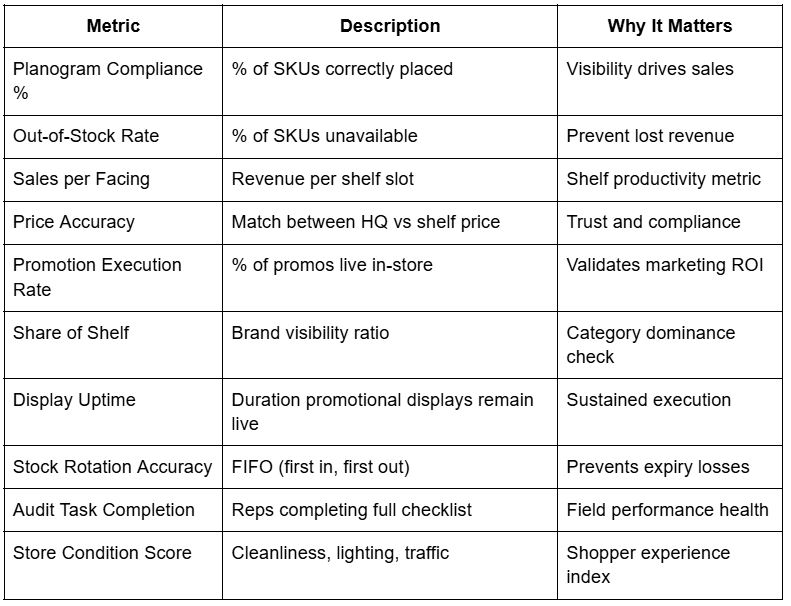Retail Audit Checklist: 40+ Advanced Metrics for Perfect Store Execution


.jpg)
“Every shelf tells a story. The question is — are you listening?”
In the world of retail, flawless execution is everything. A brilliant marketing campaign or well-planned planogram can collapse the moment it hits the shelf — if stores fail to execute it correctly.
That’s where retail audits come in.
A retail audit is a structured evaluation of what’s really happening inside your stores — how products are placed, how promotions are performing, how compliant staff are with planograms, and how the overall brand presence appears to shoppers.
Without a proper retail audit checklist, teams work blind — missing stockouts, pricing inconsistencies, and broken displays that quietly drain sales.
In fact, CPG companies lose billions each year due to execution gaps that could be caught (and fixed) early through systematic audits.
So let’s go beyond “checking shelves” and look at 40+ advanced metrics that transform audits into a data-driven growth engine.
A retail audit checklist is a detailed guide used by field reps, merchandisers, and brand teams to inspect and record in-store performance metrics.
It ensures every visit captures consistent, actionable data — not vague opinions.
In other words, it’s the difference between:
A great checklist gives retail teams visibility into execution, compliance, and shopper experience across every location. It becomes your truth source — turning field visits into business intelligence.
A strong audit starts with context. Understanding where your products live — and who shops there — shapes every insight later.
Checklist Items:
Why it matters:
Comparing audit performance by geography, demography, or store type reveals hidden patterns — like why urban stores outperform suburban ones on certain SKUs.
(Keywords: planogram compliance, shelf visibility, product damage)
Every SKU on your shelf tells the story of execution. A single missing tag or misplaced item can distort sales data and frustrate customers.
Checklist Items:
Why it matters:
These checks ensure retail reality matches HQ design. Low planogram compliance or damaged packaging directly affects sales and brand reputation.
CPG brands spend up to 20% of revenue on trade promotions, yet over half underperform due to poor execution.
Checklist Items:
Why it matters:
If promotions aren’t visible, they’re invisible — and wasted. Retail audits validate every rupee of trade marketing spend.
Your shelf is a battlefield — and your competitors are standing right beside you.
Checklist Items:
Why it matters:
These insights power category intelligence — helping you adjust pricing, packaging, and marketing faster than your rivals.
A beautiful layout that tells your story — that’s merchandising at work.
Checklist Items:
Why it matters:
Retail is visual. The moment shoppers walk in, layout and lighting shape their buying decisions. Auditing this ensures your store tells the right story.
Checklist Items:
Why it matters:
A shelf gap doesn’t just look bad — it bleeds sales and loyalty. Regular audits prevent both overstocking and understocking.
(Keywords: store staff cooperation, brand training, feedback loop)
Checklist Items:
Why it matters:
Execution lives and dies with your store teams. Listening to their insights turns them into brand advocates, not task followers.
Checklist Items:
Why it matters:
Efficient audits = more coverage, better data, and lower operational costs.

Traditional audits = paper forms and Excel chaos.
Modern audits = real-time visibility, photo proof, and AI-driven insights.
Tech Essentials:
Why it matters:
Digitization replaces subjective visits with objective, visual proof — ensuring every audit delivers measurable impact.
Pazo helps retail and CPG teams turn audits into action.
- Digital checklists — customizable per brand, region, or category.
- Photo-based verification — real-time visual proof from every store.
- Centralized dashboards — HQ monitors compliance across thousands of outlets.
- Automated alerts — instantly flag non-compliance or stock issues.
- Continuous analytics loop — connect audit data to sales outcomes.
Result:
A consistent brand presence, higher compliance, and better ROI — without endless emails and manual reports.
Retail audits are no longer optional — they’re the pulse of execution. Every photo, SKU count, and planogram check translates into actionable insights that drive brand growth.
When done right, audits go beyond inspection — they become the foundation of a smarter, more profitable retail ecosystem.
“The best brands don’t guess what’s happening in stores — they measure it.”
With the right retail audit checklist — and digital execution platform like Pazo — every visit becomes a data point, every shelf a story, and every action a step toward perfect execution.
Stay up to date with the latest video business news, strategies, and insights sent straight to your inbox!